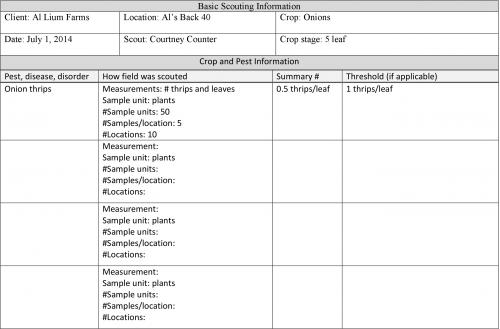Create a coversheet for clear communication of crop pest scouting data
Creating a good pest scouting coversheet can force you to think about how you will go about scouting this summer.
One of the fundamental principles of integrated pest management is that chemical controls should only be applied when pests exceed economic thresholds. To do this accurately, it is important to have good scouting data so you can apply pesticides where and when they are needed. In order for this data to be useful, it needs to be collected consistently and communicated in a way that facilitates decision making. One way some scouts do this is by creating a cover, or summary, sheet they attach along with raw counts of pest data.
Below are some tips for creating a good summary sheet, along with an example you can adapt for your operation.

Click on the picture above for an example of a pest scouting coversheet with example data. Download a blank, editable version.
Create a space for basic information
Include information common to all good scouting sheets. Make a space to record the client’s name if you are a professional scout, the geographic location where data were collected, the date data are taken and the person collecting it. For the geographic location, use consistent names that you or your clients recognize. Some growers, for example, name fields after the landowner they purchased it from. You could also create your own naming systems for your own fields.
Identify what is to be measured
Depending on the pest, you may measure different things. Specify what needs to be quantified right on the sheet to make it clear to yourself and others what is being measured.
For example, for some pests you will count the pest itself. Often you will count numbers of a specific pest life stage, such as egg masses or adults. For others you may look for incriminating evidence that the insect is present, such as defoliation of leaves.
Finally, you will need to find out whether you need to make a quantitative count or simply record the presence or absence of a pest or its damage. Quantitative counts would involve recording how many pests there are or what percentage of a leaf was defoliated. For presence or absence data, you simply record a “yes” if the pest or damage is present and “no” if it is not.
Identify the sample unit
A sample unit is the item you collect data from. This could be a single leaf, a set of leaves on a plant, an entire plant, a specified length of row or an insect trap. Identify what the sample unit is right on the scouting sheet.
How many sample units will you count per field?
Make it clear on the scouting sheet how many leaves, plants, traps or sections of row were visited at the location.
Distribution of samples throughout field
Will you collect data all at one location or multiple locations? For example, if you are counting pests on 50 plants, will you count 50 plants consecutively in a single row, or instead count 10 plants at five locations throughout a field? Make space on the scouting sheet to record the number of locations sampled and how many samples were taken per location. Consider typing this information and information described in the sections above into the coversheet to remind yourself, your employees and your clients about procedures.
To show where samples were taken, also consider leaving a blank space to draw a map of each field you scout, what locations you counted pests at or where traps are. You can label each location with a number that you also record on your raw data sheet so growers can see where pest problems were worst. For traps that stay in one place, come up with a consistent label to identify them so growers can examine trends over time.
Summary number
Create a spot for a summary number indicating overall pest pressure. This could be percent plants infested, numbers of a pest per plant, numbers of a moth pest captured per night in a trap or average percent defoliation of leaves by a pest. Ideally, put this information adjacent to the threshold for the particular pest for easy comparison.
Threshold
For whatever pest you are scouting, you can list the economic threshold recommended by Michigan State University Extension for the crop pest of interest. You can type this information into the coversheets before taking them to the field.



 Print
Print Email
Email




